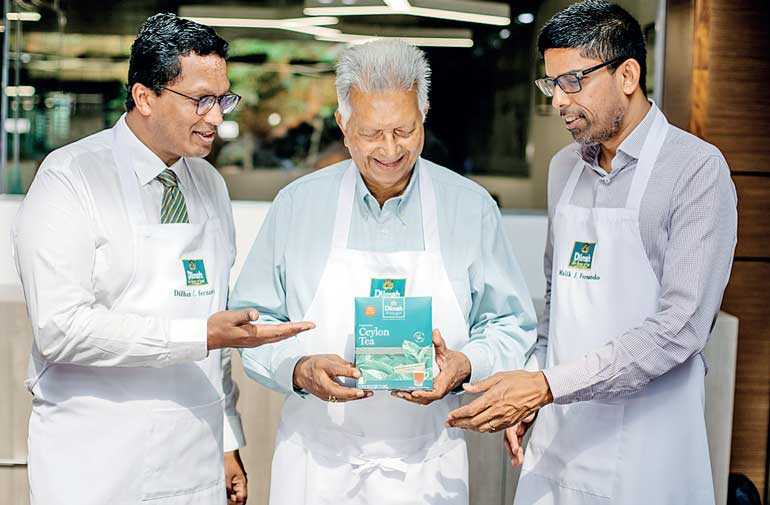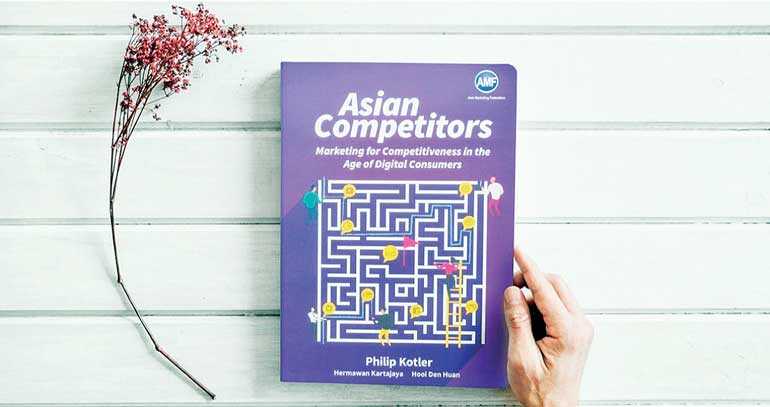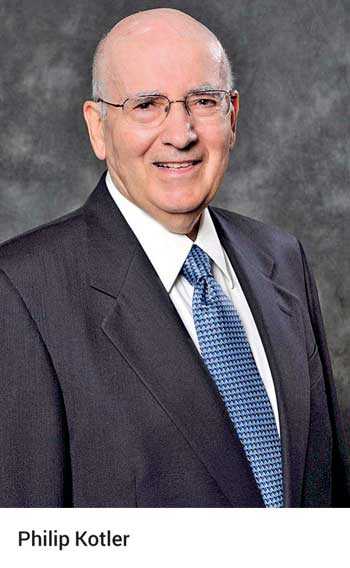Thursday Mar 06, 2025
Thursday Mar 06, 2025
Wednesday, 13 November 2019 01:15 - - {{hitsCtrl.values.hits}}

Dilmah Founder Merrill J. Fernando with his sons Dilhan C. Fernando and Malik J. Fernando

Asian Competitors, Marketing for Competitiveness in the Age of Digital Consumers
Marketing tactics, the second component of the marketing architecture, consist of three main elements: differentiation, marketing mix, and selling. Differentiation is the core tactic of the company that describes the uniqueness that it offers to the target market. This uniqueness is then created through the 4P, product, price, place and promotion (marketing mix). Further, selling is an effective tactic to build and maintain long-term relationships based on mutual benefits with customers.
In the Legacy era, it was common for Asian companies to bombard their audiences with messages through advertisements in various media. Some companies even concoct a not-so-authentic differentiation in order to be able to stand out from the crowd. Technology has, however transformed the company-customer relationship in Asia and the world, making it increasingly inclusive and horizontal. The positions of the two have become increasingly aligned. Customers can easily access information about a company from various sources, so what’s right can be easily identified by customers. In today’s New Wave era, a company should be able to cultivate an authentic uniqueness, one that cannot be easily copied by its competitors. We call this codification.
This chapter also deals with the transformation of the marketing mix elements: from product to co-creation, price to currency, place to communal activation, and promotion to conversation. In the New Wave era, the product development process takes a more ‘Horizontal’ route. Companies keenly provide several opportunities to their customers, so that they can be actively involved in various product development stages. This effectively means that the final product could be the result of co-creation between the company and its customers.
Advances in technology have also enabled companies to provide customers with greater freedom in conducting price customisation. The price to be paid is determined by the subscribers according to the features of the products they need and offerings from competitive products. We call this flexible approach of pricing and currency. 
The new technology also transforms the way companies promote to customers. As the user-generated content trend catches up, companies are focusing on putting across messages that are sufficiently creative in order to be able to trigger conversations among customers. This is contrary to the traditional unidirectional advertising where messages flow from a company to its customers. These conversations help catapult marketing messages into viral content that goes on spreading fast and wide as customers share it with people connected to them.
The final element of the marketing mix is place. It is typically the physical platform that connects companies and their customers, so that they can get their product or experience a service. As with the fundamental transformation of other elements, the internet has also led to the creation of alternative distribution channels. Together with the ease to make online payments, online distribution channels are thriving across industrial and, as a result, more companies can sell their products directly to customers.
However, what needs to be noted is that this New Wave era calls for companies to be smarter in devising the right combination of online-offline approaches, especially for target customers who are turning increasingly communal, due to the shift from segmentation to communitisation. Therefore, companies at a tactical level also need to implement the right initiatives, one of which is the utilisation of the community that is alighted with the company’s distribution channel, in terms of purpose, value, and identity. This is called communal activation.
The three cases discussed is this chapter Dilmah Tea from Sri Lanka, Cathay Pacific from Hong Kong and BlueBird from Indonesia, will show how Asian companies can implement the New Wave marketing tactics in a digital business context.
Dilmah Tea
Sri Lanka formerly known as Ceylon is considered one of the best tea producing countries in the world. Tea producers and exporters face intense competition to grow their business by sourcing exotic raw materials for this very popular beverage in this world. Amidst such a competitive situation, Dilmah tea has emerged as an authentic local brand from Sri Lanka due to the quality perceivably lacking amongst other players. Starting from the founder’s personal commitment, these in-built authenticities have eventually become the company’s brand DNA.
The story of the Ceylon tea industry
Sri Lanka known as Ceylon until 1972 is an exquisite tropical island country in South Asia. Often considered a gateway to South Asia, owing to its strategic location as a bridge connecting the eastern and western routes, Sri Lanka prides itself on its natural beauty, biodiversity, spices, gems and vast lush tea plantations (Herath, 2004). The tea industry in Sri Lanka is quite vibrant and accounts for one of the main sources of foreign exchange reserves, contributing as much as 2% of GDP (Sri Lanka Export Development Board, 2014). As of 2016, tea remains one of the main export products of Sri Lanka, besides textiles (Hong Kong Trade Development Center, 2017). The tea industry in Sri Lanka gradually developed into what it is today. Initially, tea was exported in the form of raw materials to various countries; however, eventually, Ceylon tea, which is processed, packaged, and branded by the company came to be sold at higher prices. In subsequent developments, more local producers began attempting to provide greater value through processing and packaging before the tea was exported. This value-added tea is now a major strength of the Ceylon tea industry (Herath, 2004).
However, with the emergence of many branded teas, the issue of quality came to the fore as a challenge for Ceylon tea producers and exporters in Sri Lanka. With several companies now relying on marketing campaigns to promote their products using the name ‘Ceylon Tea,’ consumers became more aware of the ‘Ceylon Tea’ brand than really knowing where Ceylon originates from (Herath, 2004). In order to offer more competitive prices; however, some of these players have not shied from compromising on quality by blending the authentic Ceylon tea with other inexpensive tea types. This eventually gave rise to the phenomenon of blended tea, increasingly popular among tea producers in Sri Lanka.
Realising the gravity of the situation, some tea producers brought it upon themselves to revive the charm of the authentic and legendary Ceylon tea. This idealism has come to be realised through the production of Ceylon tea that does not use any blending techniques (not mixing it with teas from other origins). Traditional ‘orthodox’ methods are used, which help preserve the distinctive aroma of Ceylon tea. A pioneer of that effort is Dilmah tea.
Dilmah Tea: Bringing the single-origin Ceylon tea back
At a time when large advertising budgets and wide promotion of so-called Ceylon tea brands from big corporations flooded the market, quality constantly suffered due to the availability of all the blended tea options. The return of the traditional tea was much called for. Merrill J. Fernando spearheaded the effort in 1988 when he launched Dilmah, a brand name he chose as an amalgam of the names of two of toddler sons, Dilhan and Malik (Dilmah Ceylon Tea Company, 2017a).
Born in 1930 in Pallansena, a village near Negombo, Merrill J. Fernando worked as a Ceylonese tea taster after moving to the Sri Lankan capital, Colombo. He also went on to work at big tea companies, including Lipton and Tetley. Eventually, he was sent to London for training in the 1950s, where he discovered how Ceylon teas were routinely blended with other tea types to make them more cost competitive. This served as a pivotal moment for Fernando in his quest to change the face of the Sri Lankan tea industry (Hicks, 2015).
Fernando’s determination to kick-start a transformation in Sri Lanka’s tea industry grew stronger when he found evidence of several big corporations deserting the single-origin tea in favour of blends, which made greater business sense. The aftermath was evident too; from the 1950s, when Sri Lankan tea was globally popular as a beverage, it was now being replaced by less-expensive teas from other countries, which were even preferred by buyers from the United States, Europe, and Australia. Even though those companies made more profits, producers and traders from Sri Lanka suffered a massive blow to their margins (Bajaj, 2010).
This moved Fernando to establish Dilmah, a 100% original, pure, and single Ceylon tea. At its incorporation, there was a fair share of cynics who doubted Dilmah’s ability to compete with big brands who had been there for much longer, grown more powerful, and had deeper pockets. However, with time, the concepts of the single-origin tea offered by Dilmah has lapped up the market, as tea lovers began to favour Dilmah over the blended tea. Today, Dilmah is Sri Lanka’s most recognised international brand of tea (Rosenfeld, 2015). The brand now sells in over 100 countries around the world from Estonia, the United Kingdom, Turkey, Poland, Hungary, and Chile to the United States, South Africa, New Zealand, Australia and Pakistan, Indonesia, and Japan. In 2009, Dilmah was considered the sixth largest tea brand in the world (Bajaj, 2010).
With Ceylon Tea Trails a set of luxury boutique bungalows, which were set up by revamping old tea plantations, Dilmah also ventured into tourism. These five-star bungalow resorts offer a unique period-era experience, with gourmet cuisines and butler service amidst lush tea fields and mountains. Dilmah plans to open two more such bungalows, along with 10 timeshare villas. The company has also set up what it calls ‘tea bars’ to offer tastings and classes on tea, a memorable experience for tea connoisseurs. All these efforts weaved nicely into Dilmah’s brand story and why commands a premium price amongst other teas (Bajaj, 2010).
Dilmah’s authenticities: Toward DNA codification
The success of Dilmah as the choice of tea for consumers home and abroad cannot be separated from the authenticity that the brand stands for. In today’s New Wave era, a company should be able to cultivate an authentic uniqueness; one that cannot be easily copied by its competitors. Gilmore and Pine (2007) advocated three key drivers behind the demand for authenticity. First is the overabundance of commercial experiences. Customers today are better adept at telling a real experience from a phony one. An experience which appears to be conceived forcibly, does not impress customers today and mostly considered as ‘trying too hard’. A ‘fake’ experience would likely be remembered as a waste of time, whereas a truly authentic and sincere experience would be treasured for life.
Second, with the proliferation of machines all around us, our social lives are increasingly impersonal, which also makes people yearn for something that’s more authentic, genuine, and form the heart. This is the paradox of our time: high-tech (machine-to-machine) mechanism creating the demand for high-touch (human-to-human) interaction.
Finally, several big scandals have been unearthed in recent times, resulting in a loss of faith among consumers. Consumers, therefore, look up to organisations that come across as truthful, sincere, and authentic today the most socially and environmentally responsible entities, which actually believe, and work toward and in accordance with their missions, visions, and values.
To seal its image as flag-bearer of authenticity, Dilmah began with following the concept of single-origin tea, as the family-owned company refused to conduct business in line with industry trends. Apart from the flagship single-origin teas, other specialities offered by Dilmah are garden fresh and unblended teas. Box 6.1 lists some of the authenticities that have made customers fall in love with and be loyal to Dilmah tea.
To create an authentic uniqueness, a company should be able to extend the brand internalisation of DNA beyond the marketing department. What does a brand DNA constitute? It included all the unique aspects of the brand that reflects from the common language of all employees within the company and not necessarily only those who face the customers (Barlow and Steward, 2004). In fact, the brand DNA should animate all important processes in the company, ranging from leadership, recruitment, performance appraisal, and culture building. This is what we call codification (Kotler, Kartajaya and Hooi, 2007).
In this respect, the leadership of the founder has played an integral role in building Dilmah’s codification. The undying commitment to the brand’s various authenticities, as discussed earlier, is an initiative by Merrill J. Fernando. This is also outlined in his own words on the company’s website: “My vision is to bring you tea of the highest quality. Tea that is fresh, rich in flavour and natural goodness and at the same time to give workers and my country a fairer deal. I pledged to make my business a matter of human service” (Dilmah Ceylon Tea Company, 2017a).
This sense of commitment in running Dilmah is not only passed down to his two children but also inculcated in all the employees of the company. One way it is done is through a corporate culture, which bases itself on 12 unique principles. With the involvement of all parties in realising such passion and commitment, a firm and strong corporate DNA is achieved, which helps it face external challenges. One of the most deviating temptations is the pressure to adapt to changing circumstances. This has led to many other players to blend teas form other origins. Although this is more competitive in price, it is less authentic. Dilmah’s 30-year journey has stood the test of time to its unwavering commitment to maintaining the brand DNA of the company.
Discover Kapruka, the leading online shopping platform in Sri Lanka, where you can conveniently send Gifts and Flowers to your loved ones for any event including Valentine ’s Day. Explore a wide range of popular Shopping Categories on Kapruka, including Toys, Groceries, Electronics, Birthday Cakes, Fruits, Chocolates, Flower Bouquets, Clothing, Watches, Lingerie, Gift Sets and Jewellery. Also if you’re interested in selling with Kapruka, Partner Central by Kapruka is the best solution to start with. Moreover, through Kapruka Global Shop, you can also enjoy the convenience of purchasing products from renowned platforms like Amazon and eBay and have them delivered to Sri Lanka.
Discover Kapruka, the leading online shopping platform in Sri Lanka, where you can conveniently send Gifts and Flowers to your loved ones for any event including Valentine ’s Day. Explore a wide range of popular Shopping Categories on Kapruka, including Toys, Groceries, Electronics, Birthday Cakes, Fruits, Chocolates, Flower Bouquets, Clothing, Watches, Lingerie, Gift Sets and Jewellery. Also if you’re interested in selling with Kapruka, Partner Central by Kapruka is the best solution to start with. Moreover, through Kapruka Global Shop, you can also enjoy the convenience of purchasing products from renowned platforms like Amazon and eBay and have them delivered to Sri Lanka.